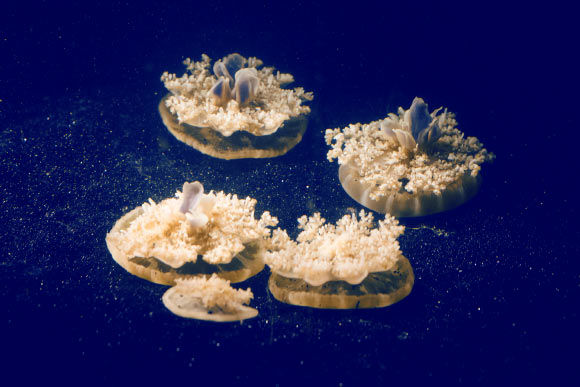Cassiopea jellyfish, a genus of true jellyfish found throughout the tropics in shallow ocean waters and mudflats, exhibit reversible behavioral quiescence during the night, according to a team of biologists at Caltech. Reported in the journal Current Biology, this finding is the first example of a sleep-like state in an organism with a diffuse nerve net, suggesting that sleep arose prior to the evolution of a centralized nervous system.

Like humans, Cassiopea jellyfish exhibit the telltale signs of sleep. Image credit: California Institute of Technology.
Researchers have long debated why animals sleep. Theories involve everything from memory, to learning, to cellular recovery.
But Dr. Paul Sternberg, a Howard Hughes Medical Institute investigator at Caltech, and co-authors want to answer something seemingly much more basic: ‘do all animals sleep?’
It’s a controversial subject. All vertebrates that scientists have studied sleep, but whether the same is true for invertebrates remains a mystery.
Previous studies have demonstrated that fruit flies, zebrafish, and mice sleep, and Dr. Sternberg and others have argued that the roundworm Caenorhabditis elegans does too. But not everyone’s convinced. Sleep in more primitive animals — like sponges and jellyfish — is even more nebulous.
“We wanted to figure this out once and for all,” Dr. Sternberg said.
To track behavior in jellyfish, the team designed an imaging system for counting the pulses of upside-down jellyfish Cassiopea spp. over successive cycles of day and night.
“Cassiopea don’t look like typical jellyfish — they’re silver dollar-sized, splotched with pigment, and rest upside down on the sea floor,” the researchers explained.
“With tentacles curled above bell-shaped bodies, the jellies resemble miniature heads of cauliflower. But they pulse like other jellyfish, contracting and relaxing in a steady rhythm, and we wondered if the behavior was continuous.”
“After recording the jellies for a minute at night and a minute during the day, we manually counted individual pulses and got their first clue that Cassiopea might be sleeping: they pulsed less frequently at night.”
“We then created an image processing program to count the pulses of 23 jellies over six consecutive days and nights. Pulsing activity ebbed at night, as we had observed earlier, but a little food dropped in the tanks could quickly wake the jellies up again.”
“It’s like the odor of coffee permeating your consciousness in the morning,” Dr. Sternberg said.
“Such an easy wake up is a sign that Cassiopea’s sluggish night-time behavior is due to sleep, not paralysis or coma.”
“It’s the first example of sleep in animals without a brain,” he added.
The scientists spotted a second sign of sleep after dropping the floor out from dozing jellies.
They placed Cassiopea inside a PVC pipe with a mesh bottom and then dipped the pipe into the tank — so submerged jellies rested on the mesh instead of the tank floor.
Then the authors lowered the pipe deeper into the tank, forcing the jellies to lift off the mesh and float in open water.
“They don’t like that,” Dr. Sternberg said.
“During the day, Cassiopea will quickly pulse their bells and swim down to rest on the mesh again. But at night, it takes them about three times longer to start pulsing. It’s like the jellyfish are a little groggy. This delayed response to stimulation is typical for sleeping animals.”
“And like other animals that sleep, jellyfish that pull an all-nighter pay for it the next morning.”
The researchers squirted tiny jets of water at Cassiopea for 6 or 12 hours at night, and then counted the jellies’ pulses the next day.
“They’re less active after losing sleep, but after they catch up on their sleep, they return to normal,” explained study first author Ravi Nath, a graduate student at Caltech.
The results suggest that Cassiopea do indeed sleep, but for Dr. Sternberg and colleagues, the work is also sparking more questions.
“Do you need neurons to sleep? Do you need more than one cell to sleep? We’d like to study sponges, or even protozoa, next and perhaps push the origin of sleep back even further,” Dr. Sternberg said.
_____
Ravi D. Nath et al. 2017. The Jellyfish Cassiopea Exhibits a Sleep-like State. Current Biology 27: 1-8; doi: 10.1016/j.cub.2017.08.014







